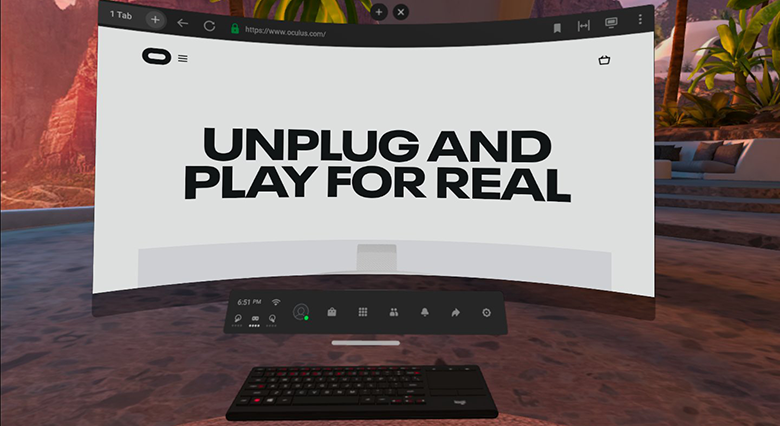
April 15, 2021 – Oculus has announced features that will begin rolling out soon in the v28 software update to Oculus Quest headsets. The main features include Oculus Air Link, a wireless way to play PC VR games on Quest 2; and new Infinite Office features, which aid with getting work done in VR. Oculus has also announced native 120 Hz support for Quest 2 for an ultra-smooth gameplay experience.
Oculus Air Link
Oculus Air Link will be coming soon to Quest 2, but will require that both the Quest 2 headset and PC are running v28 software. This means Air Link will be unlocked once both Quest and PC v28 releases are rolled out. Furthermore, the feature will only be available on devices in Experimental Mode to start with.
Built on the success of the original Oculus Link streaming pipeline that first launched in 2019, Oculus stated that it has been working on the new Air Link streaming technology in order to provide users with a completely wireless way to play PC VR content on Quest 2 using WiFi.
The company stated that Air Link will give users more options for accessing PC VR games on Quest 2. However, Oculus added that if users want to charge their headset, experience the highest-fidelity visuals possible, or if the available WiFi network is congested or unsecured, then Link via USB-C cable is still going to be the most robust and consistent experience for now, but for users with a strong and secure WiFi network and a router within roughly 20 feet of their playspace, then streaming wirelessly through Air Link will be a good option.
Oculus added that it will continue to improve Air Link’s performance and compatibility for different configurations, but in the meantime, it has published a guide for best practices and known issues, since not every network and PC setup will be ideal.
Infinite Office
At Facebook Connect, the company announced Infinite Office—a collection of new features built into Oculus Home, designed to make working in VR feel more productive and flexible. In January, Oculus rolled out the ability to find and use a Bluetooth-enabled mouse or trackpad while in VR. With the latest update, two more new features have been announced as part of the Infinite Office suite: physical surface integration and the ability to track a physical keyboard.
Launching as an experimental feature on the Quest Platform, users will be able to place a virtual desk on real furniture, allowing them to see and use it while in their Home environment. With this feature, users can also use their desk as a separate seated area to access work tools like Browser. In addition to integrating with the real environment, the virtual desk boundary is automatically saved and detected, allowing users to easily pick things up right where they left off.
Bluetooth-enabled keyboard tracking is also coming to the Quest 2, which will allow users to type as effectively in VR as they do in the real world. With this experimental feature, users will be able to sit at a physical desk and pair a Logitech K830 keyboard to their Quest 2 device, and view a 3D representation of their hands and keyboard within VR for easy text entry and system navigation while in the Home environment. Again, Oculus stated that it will expand support for this feature, with the addition of other keyboards in the future.
120 Hz support on Quest 2
Quest 2 currently runs at 90 Hz by default in system software. Oculus also opened up 90 Hz support across the entire platform last year, allowing developers to start shipping titles with native 90 Hz support on Quest 2. Now, the option to enable a 120 Hz display refresh rate on Quest 2 is being added. Developers will soon be able to ship apps on the Oculus Store that run at 120 Hz natively, while Quest 2 users will be able to opt into the 120 Hz option via a toggle in the Experimental panel to experience these applications at higher frame rates.
While there aren’t any apps that support 120 Hz just yet, people who turn on this setting will experience 120 Hz performance in apps that choose to support it in the future. Meanwhile, Quest 2 system software will remain at 90 Hz. Oculus Link support for 120 Hz will come in a future release, according to the company.
Oculus stated that its goal is to continue unlocking new capabilities of the Quest 2 hardware. The roll out of v28 will be gradual though, so users may not see the updates immediately. Still, this latest announcement certainly marks quite an exciting update to what is already an extremely impressive, popular, and accessible platform from Oculus.
Image / video credit: Oculus / Twitter
About the author
Sam Sprigg
Sam is the Founder and Managing Editor of Auganix. With a background in research and report writing, he has been covering XR industry news for the past seven years.




